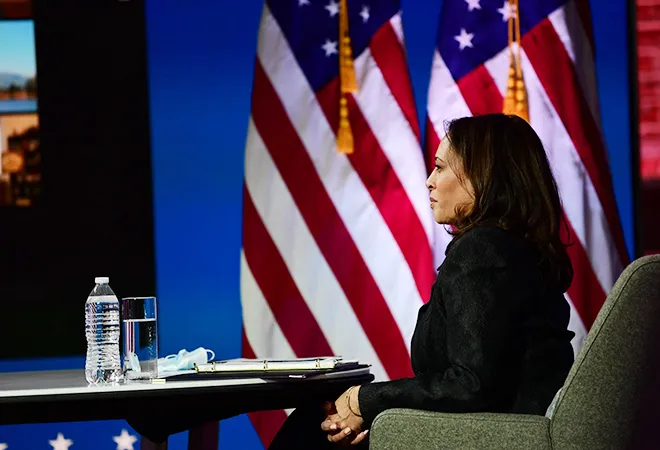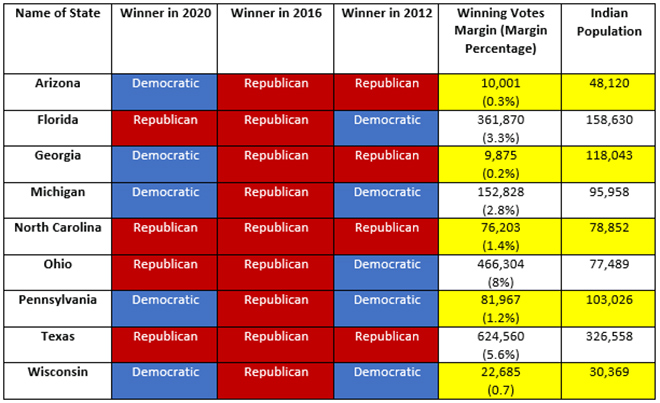
The US presidential race in November 2020 was a tightly contested one, with a significant number of voters in many ‘battleground’ states — the highly competitive states with no clear allegiances or evident leanings towards either Democrats or Republicans. Out of the 535 electoral college votes, the nine battleground states namely Arizona, Florida, Georgia, Michigan, North Carolina, Ohio, Pennsylvania, Texas and Wisconsin had a combined total of 173 votes, representing around 32 percent of the entire US population. As expected, most of these swing states were the protagonists in deciding between the Republican candidate, the incumbent president Donald Trump, and the Democratic candidate, Senator Joe Biden. In fact, the Indian-American community, the second largest immigrant group in the US is often considered to be a key constituency — especially in the swing states due to their relative affluence and high levels of educational qualifications.
As expected, most of these swing states were the protagonists in deciding between the Republican candidate, the incumbent president Donald Trump, and the Democratic candidate, Senator Joe Biden.
As depicted in the table below, all the battleground states had voted for the Republican candidate in the previous presidential elections. Marking a reversal in trend, five among the nine states have shifted towards the Democrats in 2020. However, there are no instances of any state that voted Democratic in 2016, voting for the Republicans in 2020, thereby ensuring that the Democratic candidate Joe Biden wins by a handsome margin of 74 electoral college votes. A similar reverse trend was also observed in the 2016 elections where six swing states (Florida, Iowa, Michigan, Ohio, Pennsylvania, Wisconsin) had shifted their allegiance from the 2012 presidential elections — from Democratic to Republican leading to an electoral college difference of 77 votes. Six other potential swing states (Iowa, Maine, Minnesota, Nebraska, Nevada, New Hampshire) are identified this time which have less than a 10 percent difference between the top two candidates in terms of the number of popular votes for the 2020 presidential elections. Although, the exact voting trend for the Indian-American community is still speculative there is no doubt that this immigrant group was of paramount importance in the battleground states where small shifts in allegiance can tip the balance in favour of one party or another.
Table: Election Results in the Swing States
 Source: Authors own; data from ORF Report, 270towin.com, BBC News and NPR
Source: Authors own; data from ORF Report, 270towin.com, BBC News and NPR
Candidates from both the parties had campaigned more heavily in these states compared to the other ones, in a strong attempt to reach out to the Indian-American voters. These ranged from Trump leveraging on his friendly interactions with Prime Minister Narendra Modi over the years to Biden reminiscing about hosting the White House Diwali celebrations in 2012. As also seen in the table above, the number of Indian-Americans exceeds the winning margin of the 2020 presidential elections in five out of nine states (highlighted in yellow), with four out of those five states voting for the Democratic candidate, Joe Biden. Although, the exact numbers of the Indian-American electorate in these states are unavailable, these figures are indicative of the fact that the community might have continued to harbour its support for the Democratic party in the 2020 elections as well. An ORF report on the US elections 2020 tried to capture how the Indian-American population has become a political force to reckon within all 50 states, due to their growing numbers and outsized impact. It also points out the growing cultural influence of the Indian communities in many states and engages with key individuals of Indian descent in US who could be pivotal in terms of growing the Indian-American vote bank in the US.
Prior to the elections, there was a perceived “shift” among older generation Indian-Americans, in response to Trump’s significant overtures towards a Modi-led India.
According to a survey, Indian-American community in the US was believed to be swerving towards the Republican party — with support by the Indian-Americans for Democratic candidate Hilary Clinton in the 2016 elections standing at 77 percent compared to the support for Democratic candidate Joe Biden at 66 percent in 2020. Prior to the elections, there was a perceived “shift” among older generation Indian-Americans, in response to Trump’s significant overtures towards a Modi-led India and a number of spectacular rallies with the prime minister which have caught the attention of these voters. Meanwhile, Biden’s choice of Kamala Harris as his running mate also became important in wooing the Indian-American community, as discussions regarding her Indian origin became salient in the run up to the elections.
Due to the ongoing COVID-19 pandemic, the early votes in the US is about 65 percent of the voting-eligible population nationally, that amounts to about 150 million voters — the highest in a century. Due to the tedious process of counting the mail-in ballots, five states went without projected winners even five days after the elections due to a backlog caused by the higher number of mail-in ballots and the small margin of winning votes. Six out of these nine states where significant projections could not be carried out by the night of the polling day, were amongst the battleground states mentioned above. With the difference in popular votes between Trump and Biden in some states coming down to a matter of less than one percent, like in the swing states of Arizona, Georgia and Wisconsin — there is no doubt that although Trump did put up a good fight in these states but lost them to the Democrats by a narrow margin. However, Biden’s overall win and strong support from the Indian-Americans bring into question the accuracy of the claims that the Indian-American community was shifting its support towards the Republican Party.
With the difference in popular votes between Trump and Biden in some states coming down to a matter of less than one percent — there is no doubt that although Trump did put up a good fight.
Along with several people of Indian origin running for various offices in state legislatures, justices of courts and mayoral offices representing both sides of the aisle — all four incumbents Indian-Americans, unofficially called the Samosa Caucus, won their re-election as Democrats to the House of Representatives. Although the Indian-American demographic does not represent a huge chunk of the total US population — but with a population that grew by nearly one hundred and fifty percent between 2008 and 2018, the Indian community with its high potential for political mobilization and donations should have an increasing say in American politics in future elections as well.
The author acknowledges Suyash Das, Research Intern at ORF Kolkata, for assistance with the article.
The views expressed above belong to the author(s). ORF research and analyses now available on Telegram! Click here to access our curated content — blogs, longforms and interviews.




 Source: Authors own; data from
Source: Authors own; data from  PREV
PREV


